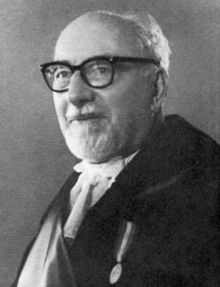Francesco Tricomi
Francesco Giacomo Tricomi | |
|---|---|
 | |
| Born | Francesco Giacomo Tricomi 5 May 1897 Naples, Italy |
| Died | 21 November 1978 (aged 81) Turin, Italy |
| Nationality | Italian |
| Alma mater | University of Bologna University of Naples |
| Known for | Tricomi function Tricomi–Carlitz polynomial Euler–Tricomi equation |
| Spouse | Susanna Fomm |
| Scientific career | |
| Fields | Mathematics |
| Institutions | University of Padua University of Rome University of Florence University of Turin |
Francesco Giacomo Tricomi (5 May 1897 – 21 November 1978) was an Italian mathematician famous for his studies on mixed type partial differential equations.[1] He was also the author of a book on integral equations.
Biography
[edit]
Tricomi was born in Naples. He first enrolled in the University of Bologna, where he took chemistry courses. However, Tricomi realized that he preferred physics rather than chemistry; he moved to the University of Naples in 1915.[2] He graduated at the University of Naples in 1918 and later was assistant to Francesco Severi, first in Padua and then in Rome. Later he was professor at Turin, called by Giuseppe Peano, a position he held until his retirement in 1967.
He was an Invited Speaker of the ICM in 1928 at Bologna[3] and in 1932 in Zurich. From 1943 to 1945 and from 1948 to 1951 at the California Institute of Technology of Pasadena, he collaborated on the manual of special functions for the Bateman manuscript project, together with Arthur Erdélyi, Wilhelm Magnus and Fritz Oberhettinger.
Tricomi was a member of the Accademia nazionale dei Lincei and of the Accademia delle Scienze di Torino (Turin Academy of Sciences), of which he was also president.
Selected publications
[edit]- Vorlesungen über Orthogonalreihen, Springer Verlag, Berlino, 1955 (traduzione di: Serie ortogonali di funzioni, Istituto Editoriale Gheroni, 1948)[4]
- Integral Equations, Dover, New York, 1985, ISBN 0486648281; 1st edition. 1957.[5]
- Equazioni differenziali, 3rd edition, Boringhieri, 1961 (translated by Elizabeth McHarg into English as Differential Equations. NY: Hafner. 1961.); 1st edition. Torino: G. Einaudi. 1948.[6] 2nd edition. 1953.[7]
- Carlo Ferrari[8] e Francesco Giacomo Tricomi, Aerodinamica transonica, Cremonese, Roma, 1962 ISBN 8870833658
- Funzioni Analitiche, Nicola Zanichelli Editore, Bologna, 1961 (reprint of 2nd edn.); 1st edition. 1937.[9] 2nd edition. 1946.[10]
- Lezioni sulle funzioni ipergeometriche confluenti, Gheroni, Torino, 1952[11]
- Funzioni ipergeometriche confluenti, Cremonese, Roma, 1954[12]
- Funzioni ellittiche, Nicola Zanichelli Editore, Bologna, 1937[9]
- Lezioni di analisi matematica, CEDAM, 1965, ISBN 8813319509
- Esercizi e complementi di analisi matematica, CEDAM, 1951
- Lezioni sulle equazioni a derivate parziali, Editrice Gheroni Torino, 1954[13]
- Equazioni a derivate parziali, Edizioni Cremonese, Roma, 1957[14]
- A. Erdélyi, W. Magnus F. Oberhettinger, F. G. Tricomi, Higher transcendental functions. (3 vols.), McGraw-Hill, New York, 1953 (fa parte del Bateman manuscript project)
- A. Erdélyi, W. Magnus F. Oberhettinger, F. G. Tricomi, Tables of integral transforms, McGraw-Hill, New York, 1954 (fa parte del Bateman manuscript project)
- Tricomi, Francesco G. (1967), La mia vita di matematico attraverso la cronistoria dei miei lavori. (Bibliografia commentata 1916–1967), Padova: CEDAM – Casa Editrice Dott. Antonio Milani, pp. XII+172, ISBN 978-88-13-32679-1, MR 0274255, Zbl 0199.28603.
See also
[edit]References
[edit]Biographical and general references
[edit]- Fichera, Gaetano (1979), "Francesco Giacomo Tricomi", Atti della Accademia Nazionale dei Lincei. Rendiconti. Classe di Scienze Fisiche, Matematiche e Naturali, Series VIII (in Italian), LXVI (5): 467–483, ISSN 0392-7881, MR 0606447, Zbl 0463.01022.
Notes
[edit]- ^ "Biography by J.J. O'Connor and E F Robertson". Archived from the original on 2019-06-05. Retrieved 2008-10-18.
- ^ "Francesco Tricomi - Biography". Maths History. Retrieved 2022-12-18.
- ^ Tricomi, F. (1929). "Sull'equazione y ∂2z/∂x2 + ∂2z/∂y2 = 0." (PDF). In: Atti del Congresso Internazionale dei Matematici: Bologna del 3 al 10 de settembre di 1928. Vol. 3. pp. 27–30. Archived from the original (PDF) on 2017-12-05. Retrieved 2017-12-04.
- ^ Erdélyi, A. (1961). "Review: Vorlesungen über Orthogonalreihen by F. G. Tricomi, trans. by F. Kasch" (PDF). Bull. Amer. Math. Soc. 67 (5): 447–449. doi:10.1090/s0002-9904-1961-10625-3.
- ^ Heins, Albert E. (1958). "Review: Integral equations by F. G. Tricomi" (PDF). Bull. Amer. Math. Soc. 64 (4): 197–198. doi:10.1090/s0002-9904-1958-10207-4.
- ^ Murray, F. J. (1950). "Review: Equazioni differenziali by F. G. Tricomi" (PDF). Bull. Amer. Math. Soc. 56 (2): 195–196. doi:10.1090/s0002-9904-1950-09383-5.
- ^ Reid, W. T. (1955). "Review: Equazioni differenziali, 2nd ed., 1953, by F. G. Tricomi" (PDF). Bull. Amer. Math. Soc. 61 (4): 371–372. doi:10.1090/s0002-9904-1955-09962-2.
- ^ Then full professor in Applied Mechanics at the Polytechnic University of Turin
- ^ a b Raynor, G. E. (1938). "Review of Funzioni Analitiche and Funzioni Ellittiche by F. G. Tricomi" (PDF). Bull. Amer. Math. Soc. 44, Part 1 (9): 610–611. doi:10.1090/S0002-9904-1938-06798-5.
- ^ Strodt, Walter (1947). "Review: Funzioni Analitiche, 2nd ed., by F. G. Tricomi" (PDF). Bull. Amer. Math. Soc. 53 (7): 739–740. doi:10.1090/s0002-9904-1947-08845-5.
- ^ Erdélyi, A. (1954). "Review of two books: "Lezioni sulle funzioni ipergeometriche confluenti" by F. G. Tricomi and "Die konfluente hypergeometrische Funktion, mit besonderer Berücksichtigung ihrer Anwendungen" by Herbert Buchholz" (PDF). Bull. Amer. Math. Soc. 60 (2): 185–189.
- ^ Erdélyi, A. (1955). "Review: Funzioni ipergeometriche confluenti by F. G. Tricomi" (PDF). Bull. Amer. Math. Soc. 61 (5): 456–460. doi:10.1090/s0002-9904-1955-09956-7.
- ^ Bellman, Richard (1955). "Review: Lezioni sulle equazioni a derivate parziali by F. G. Tricomi" (PDF). Bull. Amer. Math. Soc. 61 (5): 87–88. doi:10.1090/S0002-9904-1955-09875-6.
- ^ Heins, A. E. (1959). "Review: Equazioni a derivate parziali by F. G. Tricomi" (PDF). Bull. Amer. Math. Soc. 65 (3): 169–170. doi:10.1090/s0002-9904-1959-10316-5.
External links
[edit]- Page at Accademia delle Scienze of Turin (in English)
- Integral Equations by F.G. Tricomi (in English)
